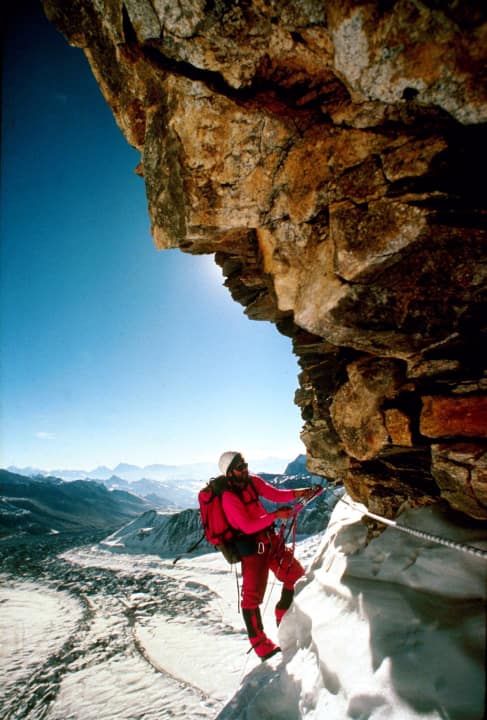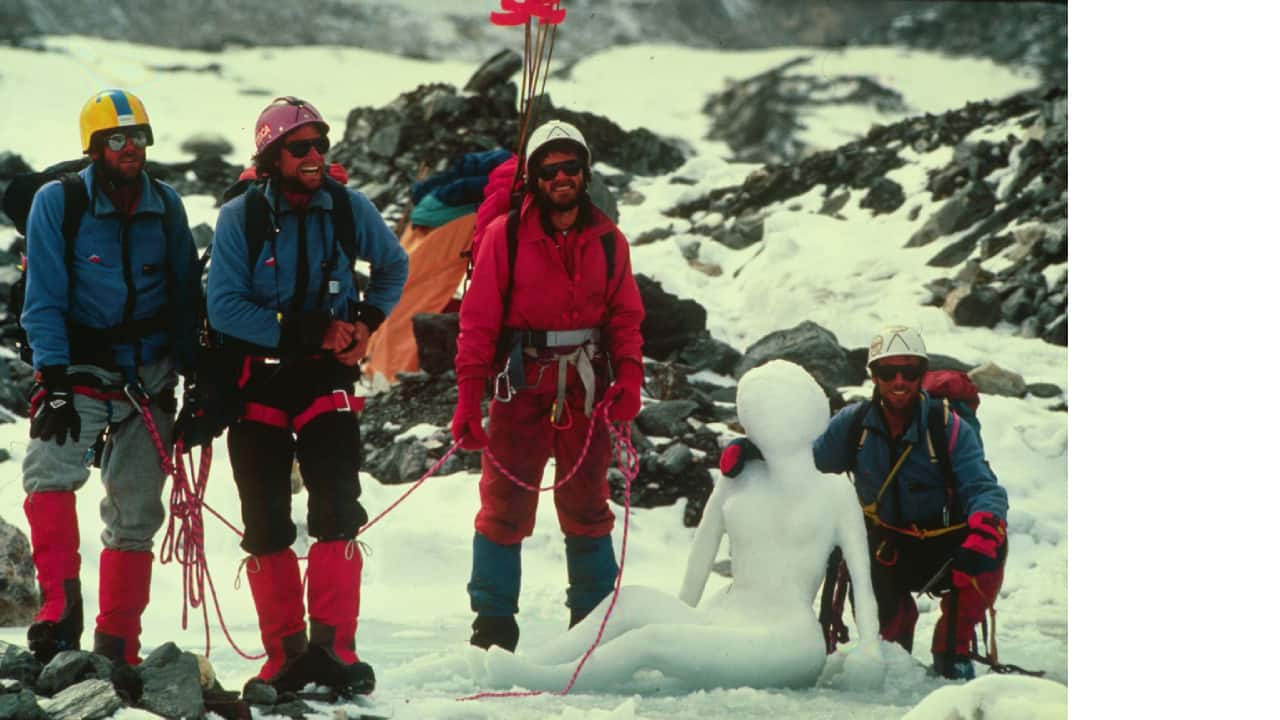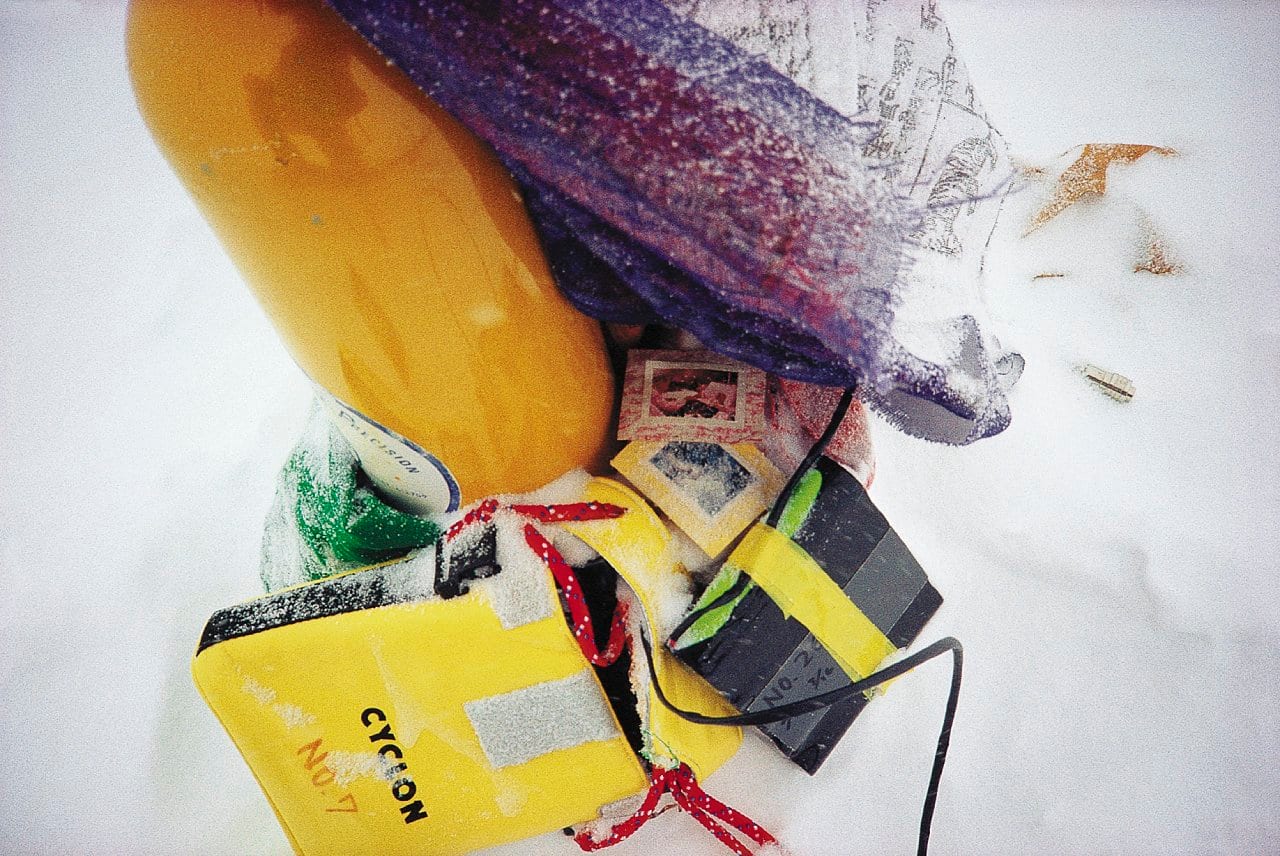



The wait had been unnerving for those at Advance Base Camp (ABC). Over the last few days, their routine had been to scan the slopes of Mt Everest in the hope that they would spot their teammates. As per the schedule, they were to return after five days; nine days on, there was no sign of them.
“It was one of the worst things that I’ve been through,” recalls Mimi Zieman, a student of medicine who had joined the expedition as the team doctor. “It was heartbreaking to sit there and wait, quite traumatic. I thought they were dead, the guys I had become so close to during those weeks,” she adds.
Search and rescue had been called for. But for now, there was little to do. ABC had been wrapped up, and Zieman and Paul Teare had decided to start heading back to civilization the following day.
It took sleeping pills for the duo to catch some rest. But in the dead of the night, Teare thought he heard a voice. Still groggy, he rushed out of the tent and listened intently - there it was again. Soon, an apparition stumbled towards him on the starlit glacier.
 Sunrise on Everest (Photo by Stephen Venables)
Sunrise on Everest (Photo by Stephen Venables)
***
Thirty-five years ago on May 13, 1988, Stephen Venables stood all alone on the summit of Everest. It was a different time, a far cry from the jamboree that unfolds on the mountain these days. Only two other climbers were with him - teammates Ed Webster and Robert Anderson - still a few hundred metres below, torn between their summit aspirations and survival.
Their climb had been extraordinary in many ways. This four-man team had taken a new route up the daunting Kangshung Face of Everest, without oxygen or high-altitude support, and with no communication with the outside world. It meant tackling every chore on the expedition on their own - opening the route, setting up and stocking camps, melting ice to hydrate and cooking meals, besides of course, rescuing themselves if the need arose.
The International Everest Expedition of 1988 was to celebrate the 35th anniversary of the first ascent of Everest in 1953, when Tenzing Norgay and Edmund Hillary had reached the summit as part of a team led by John Hunt.
Hunt was made the honorary leader of the 1988 International Everest Expedition as well. On his recommendation, Venables, a relative stranger to the rest, had been added to the team comprising Anderson and Webster, who were seasoned big wall climbers from the United States, besides Teare, a Canadian.
“I wanted climbers that had varied skill sets and who were accustomed to doing new routes. It’s a real art to find a way where nobody has been before,” says Anderson.
Before setting off for Everest, Venables had met veteran American climber, Charles Houston, in India.
“He simply said - Kangshung Face, four people, you’re quite mad. Go climb a smaller mountain,” Venables recalls.
“I was taken aback because we had huge doubts and a lot of others had been very skeptical. So we went with a good deal of trepidation,” Venables says.
 Ed Webster on the Kangshung Face. (Photo credit: Stephen Venables)
Ed Webster on the Kangshung Face. (Photo credit: Stephen Venables)
***
The march to base camp set the tone for the weeks ahead. Heavy snowfall stranded the team at the foot of Langma La for over two weeks. Since the yaks couldn’t make progress, the team had to wait for Tibetans from neighbouring villages to help ferry loads to base camp.
“It was a huge exercise in patience and a good introduction to the crazy weather we ended up having during the entire trip,” Zieman says.
A massive avalanche tumbled down the Lhotse Wall to the left of their route, a grand welcome to the start of the real climbing on April 3. After crossing the glacier from ABC (5,450m), the lower section of the route featured a buttress that required hard technical climbing over a thousand vertical metres. The snow slopes here on led to the South Col (7,986m), from where the standard route along the South East Ridge ended on the summit of Everest (8,848m).
Each morning would start at 3am, followed by long gruelling days of route opening and tricky navigation below ice towers that threatened to wipe out anything in their path. By the time they were back at ABC, the climbers had just about enough energy to tuck in a meal and hit the sack. The buttress they were tackling was soon christened “the Neverest (Never-rest) Buttress”.
“I came up with that, part of my advertising background,” Anderson says, laughing.
 Robert Anderson jumaring up the headwall. (Photo credit: Stephen Venables)
Robert Anderson jumaring up the headwall. (Photo credit: Stephen Venables)
“Four days into the climb, we thought we could quite possibly get killed. There were sections where we climbed without any protection, some on steep ice and bad rock. It was pretty much committing to one pitch after another, sharing the responsibility to keep making progress. Those were some of the most challenging days that Everest had ever had, but it was really exciting as a climber,” he adds.
Just when Venables thought he had made it to the upper slopes, he realized a gaping crevasse at the top of the final ice tower, 100 feet deep and 50 feet wide, a tricky proposition to say the least. Webster had to descend into what he called the “Jaws of Doom” and ascend a sheer ice wall, before they could set up a Tyrolean traverse across it.
“That was the most spectacular bit of climbing Ed and Robert dealt with while bridging the crevasse,” Venables recalls.
“The entire route opening effort was like an extended game of Snakes and Ladders. And each time, it seemed like we were being sent back to the start,” he adds.
Days of bad weather set their plans astray. It took close to a month to establish Camp 2 (7,450m) on the upper slopes. On May 8, 1988, their tenth trip to Camp 1, they finally set off for the summit.
 Robert Anderson, Paul Teare, Ed Webster and Stephen Venables at Advanced Base Camp. (Photo credit: Joe Blackburn)
Robert Anderson, Paul Teare, Ed Webster and Stephen Venables at Advanced Base Camp. (Photo credit: Joe Blackburn)
***
Two days later, Webster was the first to top out on the barren South Col, battered by high winds that made it a task to set up tents. It had taken 11 hours to ascend 500 metres in deep snow from Camp 2.
In the next few moments, they decided to spend another day at South Col, hoping for calmer weather when they started for the top. But the altitude had already taken a toll on Teare, what they thought to be the onset of cerebral edema. It was evident that he would have to descend in order to survive.
“There was a lot of concern and while we were discussing the next course of action, Paul walked up to us and said he was leaving. He literally took the decision away from us. Make me proud, he said, and he was gone,” Anderson recalls. “One of us should have gone down with him, but he didn’t want to take the summit away from any of us,” he adds.
The mountain gods were kind to them the following day. As the winds dropped, the trio set off for the top on the night of May 12. Soon, Venables was off on his own.
“Things can change drastically at that altitude. We were all on our own up there and if someone could go on, I encouraged them to keep climbing,” Anderson says.
With no signs of the route ahead, it was tedious progress in the dark. Things got better once the sun came up, but the fatigue from the climb and the lack of supplemental oxygen meant slow progress up the ridge. That evening, Anderson had an important decision to make.
“It was 4pm by the time I got to the South Summit (8,750m). I was in a whiteout, struggling to figure the way ahead. Had I continued, I’m quite certain it would have killed me,” Anderson says.
He descended to meet Webster and as darkness approached, they got into a tent left behind by another expedition.
 The only summit photo Venables could make, his reflection is seen on the oxygen bottle left behind by a previous expedition. (Photo credit: Stephen Venables)
The only summit photo Venables could make, his reflection is seen on the oxygen bottle left behind by a previous expedition. (Photo credit: Stephen Venables)
***
Above them, Venables was struggling. He had been “completely knocked out” by the altitude, but he was determined to push on to set aside his previous disappointments in the Himalaya.
“Three years ago, Venables had come very close to making the first ascent of Rimo I in Ladakh. But at summit camp, he had dropped his rucksack and had no choice but to descend,” recalls Mumbai-based mountaineer, Harish Kapadia, his teammate on the expedition.
The odds were stacked up, but at 3.40pm on May 12, Venables stood on the summit - the first Britisher and among a handful to make an oxygen-less climb on Everest. He scattered some flower petals that Kapadia’s sons had handed him and after 10 minutes, started descending.
“A huge thrill, a huge relief, a really special moment. Because there had been no certainty about it. Yet, I was disappointed that the entire team was not up there,” Venables recalls.
That, however, was just half the job done, the descent is often more taxing as any climber would know. It soon started snowing and Venables found the going rough. The hallucinations he had experienced on the way up were now stronger than ever, an “old man” keeping him company on the tedious descent in fading light. At the suggestion of his “partner”, Venables decided to sit there in the snow at 8,600 metres, awaiting first light.
“You drift in and out of reality, a whole lifetime of random experiences that present themselves in your mind. It all feels so real and then you sort of grab hold of reality and say - this is all nonsense. And then you are simply drifting back into it,” Venables says.
“But I had every intention of being awake and alive in the morning,” he adds.
 Stephen Venables at Advanced Base Camp after the climb. (Photo credit: Joe Blackburn)***
Stephen Venables at Advanced Base Camp after the climb. (Photo credit: Joe Blackburn)***
Anderson remembers a snowman descending towards them the following morning. Though united after 30 hours, this was a spent force and on reaching South Col, they collapsed in their tents, just about managing to boil water to keep themselves hydrated.
After four days in the Death Zone (above 8,000 metres), they finally got off the South Col on May 14. Webster led the way, his frostbitten fingers causing him great distress. On his tail was Anderson, soon caught in an avalanche, fighting for survival.
“I cartwheeled down the mountain for about a 100 metres before finally coming to a halt, losing my ice axe in the process. I remember it vividly - the moments when you would have probably died remain with you,” Anderson recalls.
It took a massive effort to get to Camp 2, where they struggled with the most menial tasks. All they could do was lie around and hope to regain some strength in order to continue their descent. After two nights of lethargy and indecision, Webster stirred them into action by announcing that they had to get moving or they were going to die.
“The trickiest part was to just stand up and start walking, real wobbly steps and no balance. I was sitting there in the sun thinking I’ll be there just a bit longer when Ed told me - Stephen you better get down or you won’t be able to enjoy being famous,” Venables recalls.
“We thought the descent would be a day at most, but it took us five days to get off the mountain from South Col,” Anderson adds.
Anderson spent another night above Camp 1, keeping busy digging a hole in the snow, while shivering and hallucinating the rest of the time. But when he finally stumbled into ABC, he was better off than the others.
Zieman, who had shuttled between extremes of excitement and boredom at base camp, now had her hands full.
“There was no time to sleep since I had to treat frostbites on Ed’s and Rob’s hands and on the feet of all three. They were emotionally devastated, especially Ed, since his injuries were far worse. It was a lot to deal with as a student,” she says.
Their recovery was long, more psychological than physical for a few of them. Webster, Venables and Anderson all suffered amputations to their digits.
“It was life changing for all of us in many ways, certainly some of the more dangerous things we’ve done,” Anderson says.
“I think maybe some of my ambitions had been dealt with, the sharp edges smoothened. According to my wife, I became a nicer person after Everest,” Venables says, laughing.
***
Before flying home, Venables visited Kapadia again in Mumbai. When he mentioned the “old man” he had met high up on Everest, Kapadia reached out for a photo of the philosopher, Sri Aurobindo.
Venables’ eyes lit up, as he recognised his “companion” who had kept him alive that night.
“Those flowers he had scattered on Everest were from the Aurobindo Ashram in Pondicherry,” Kapadia says.
Discover the latest Business News, Sensex, and Nifty updates. Obtain Personal Finance insights, tax queries, and expert opinions on Moneycontrol or download the Moneycontrol App to stay updated!